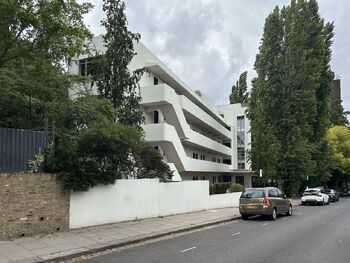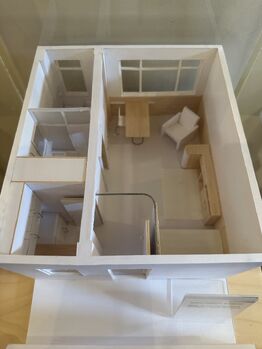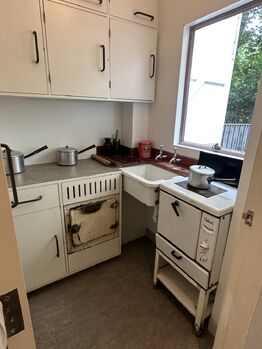The Isokon Building, also known as the Isokon Flats or the Lawn Road Flats in Christie's time, is a block of apartments located on Lawn Road in the Belsize Park dstrict of the London Borough of Camden. Agatha Christie and her husband Max Mallowan moved into apartments in this building in 1940 at the height of the blitz during World War II shortly after their house at 58 Sheffield Terrace was damaged by bombing (they had fortunately been out of town during that raid). When Max was posted to the Middle-east around 1942, Christie continued to live at the Lawn Road Flats while writing and also working as a dispenser at University College Hospital.
The Isokon Building was originally designed by Canadian engineer Wells Coates for Molly and Jack Pritchard in a minimalist modernist style. Apartments in the buulding were also fitted out with furniture of a modernist design made by Pritchard's Isokon company. During the Second World War, the building owners marketed the property as one of the safest in London because it had a reinforced concrete structure and also because they had it painted dark brown to serve as camouflage. After the bombing of Sheffield Terrace, the Mallowans at first rented unit 22 and moved in in Mar 1941. Subsequently, Max was posted to the Middle-east, Christie moved into unit 17. Max returned to Britain in May 1945 and the couple continued to stay at the Lawn Road Flats until 1947. During this time they also rented unit 16 and got permission to knock down the dividing wall and amalgamate the two units.
Christie's time at the Isokon Building was another productive one. Besides volunteering as a dispenser by day, she would spend the nights writing, sometimes two novels at the same time. Works she is known to have written during her stay here include: The Body in the Library[1] Five Little Pigs, The Moving Finger, Sparkling Cyanide, Towards Zero, Death Comes as the End, Absent in the Spring and Three Blind Mice (radio play) (which became the basis for The Mousetrap.[2] She also adapted an earlier play into Moon on the Nile, completing it in December 1942.[3] Christie also mentions that she worked on N or M? at Lawn Road[4] but this was first serialised in March 1941, the same month she moved into Lawn Road. So either she was just putting finishing touches or saw it come out in print while staying there.
The Isokon Building hosted many celebrity residents, most notably Bauhaus émigré architects Walter Gropius, Marcel Breuer, and László Moholy-Nagy. There was also a spy-ring operating in the building, with Arnold Deutsch, a key Soviet agent, living there in the 1930s.[5] However the belief that N or M? was inspired by Christie meeting Soviet spies at the building is not plausible. N or M was written earlier before she moved in and when she arrived, Deutsch had already moved out.[6]
Of her time in the Lawn Road flats, Christie wrote: "[As] I pass a funny old building like a liner I shall always look up at it and say to myself, 'I was happy there!' No beauty to speak of ... but oh darling I did have so much happiness there with you,"[7]
In 1972 the building was sold to Camden London Borough Council and suffered a decline into the 1990s and became derelict. In 1999 it became Grade I listed and was subsequently refurbished in 2001, restoring it to its 1930s miminalist look: Christie described the building as one which looks like a liner and ought really to have funnels. While the units are private and cannot be visited, part of the refurbishment involved the creation of the Isokon Gallery, an exhibition space created in the former garage with displays about the story of the building, the social and artistic life of its residents and Isokon furniture company. Among its special exhbitions is one running from 2021-2022 about the life and work of Agatha Christie.[6][8]
References[]
- ↑ Agatha Christie, An Autobiography (London: HarperCollins, 2010), 436, ebook edition.
- ↑ Leyla Daybeige, "Agatha Christie: The Modernist War Years at the Isokon Gallery", C20 Society.org, 14 Jun 2021. URL
- ↑ Janet Morgan, Agatha Christie: A Biography (London: HarperCollins, 2017), 160, ebook edition.
- ↑ Agatha Christie, An Autobiography (London: HarperCollins, 2010), 436, ebook edition.
- ↑ The Secret History of the Isokon Building
- ↑ 6.0 6.1 Bridget Galton, "How Agatha Christie spent the war in Hampstead," Hampstead Highgate Express, 18 May 2021, URL or see archive URL
- ↑ Letter from Agatha Christie to Max Mallowan 27 Oct 1942 quoted in Laura Thompson, Agatha Christie, A Mysterious Life (London: Headline, 2007), 271, ebook edition.
- ↑ This webpage of the Agatha Christie exhibition at the Isokon Gallery includes a video which describes Christie's time at Isokon. The video may also be found here.







